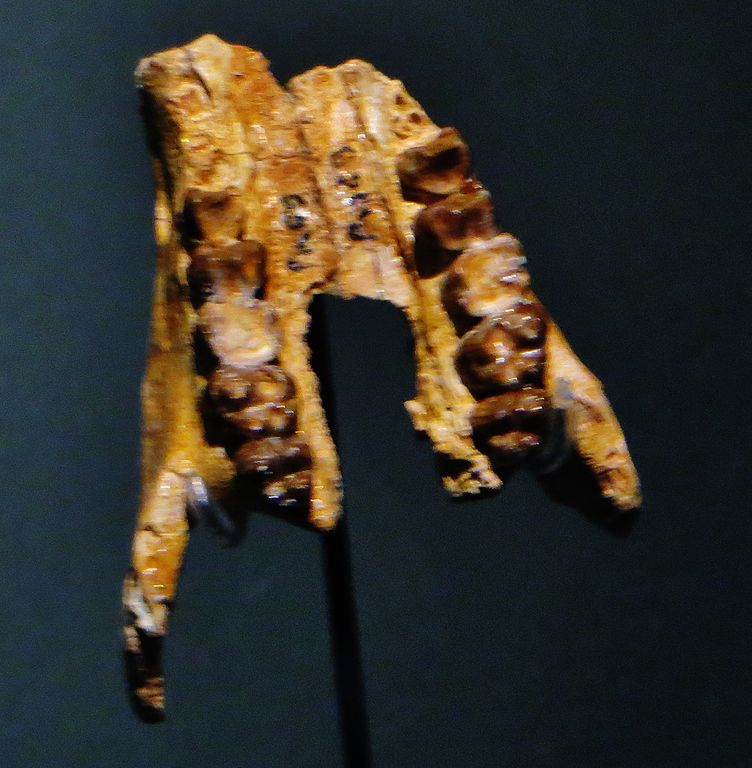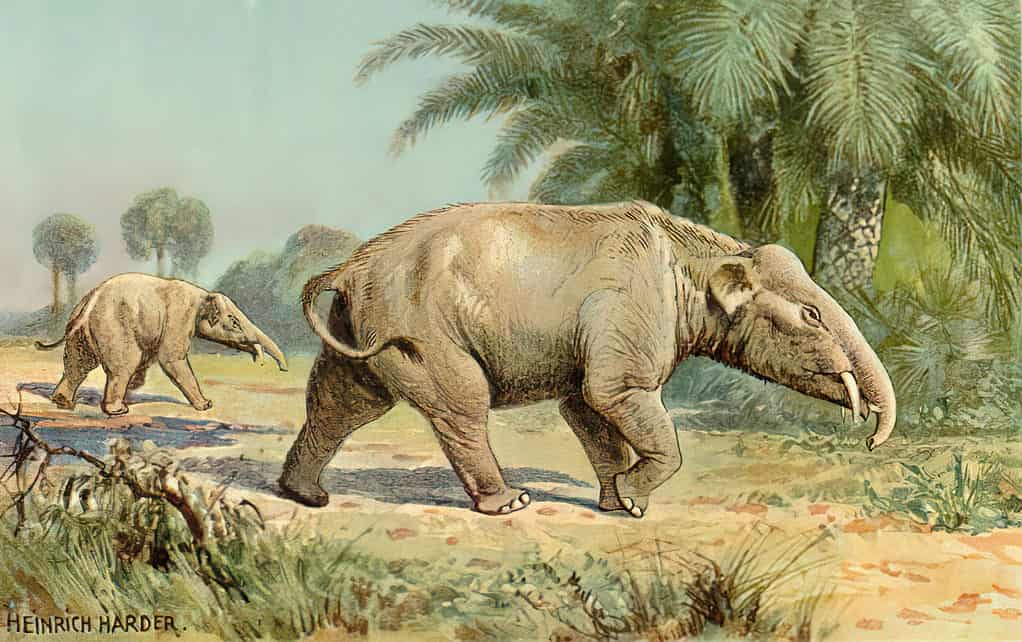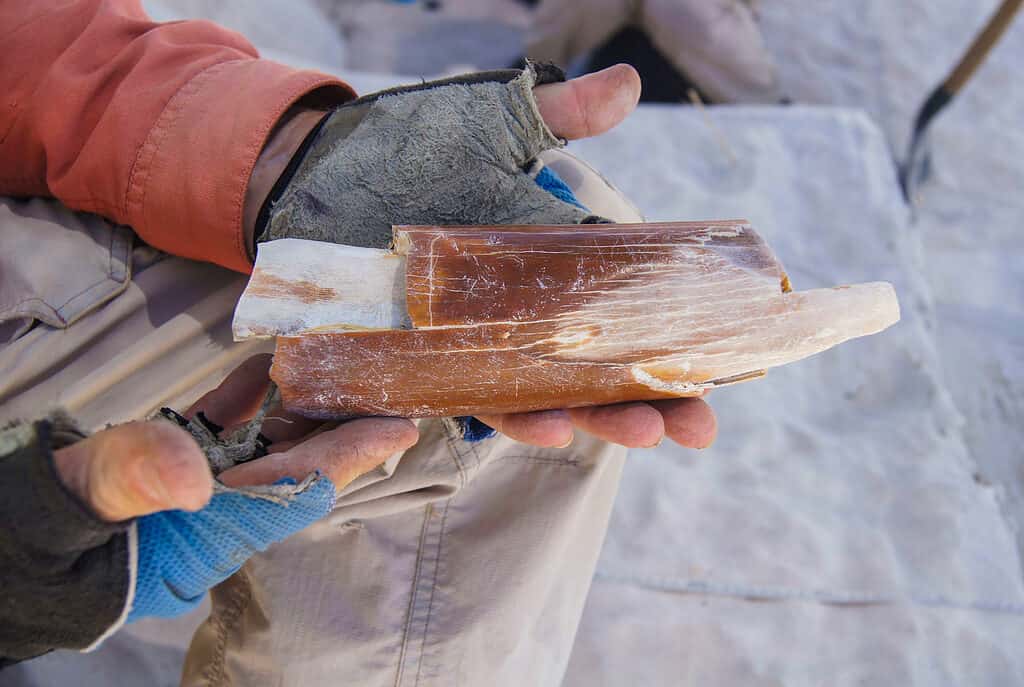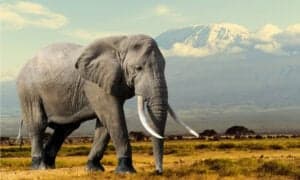Elephants are very large, powerful creatures that roam Africa and parts of Asia in modern times. Their ancestors were once far more widespread, and humans have found evidence of these creatures in Africa, Asia, Europe, and the Americas. However, the creatures that once lived in these lands millions of years ago were very different from the ones we know today. So, what’s the oldest elephant fossil ever found, and what does it tell us about these animals?
We’ll take a very close look at these fossils as well as some of the evolutionary history of the large, gray mammals. Keep in mind that mapping the evolutionary history of these animals is difficult. The dates of the fossils, as well as the appearances of various creatures, are not set in stone.
What Is the Oldest Elephant Species?

Scientists estimate that eritherium came between 55 and 61 million years ago.
©Ghedoghedo / CC BY-SA 4.0 – License
When trying to determine the oldest elephant, we have to look back at the first member of the creature’s family. In this case, we’re going back millions of years to the first elephant ancestor, a creature called Eritherium.
The Eritherium azzouzorum species lived about 60 million years ago. Scientists discovered fossils from his animal in Morocco. The scientists proposed that they came from the early late Paleocene, between 55 and 61 million years ago.
This species looks nothing like the modern elephant despite belonging to the same order as them, Proboscidea. Some estimates say that these creatures measured about 8 inches tall and weighed about 11 pounds at their maximum.
The proboscideans didn’t rapidly change until about 20 million years ago. Scientists believe that during that time, these creatures began to steadily evolve in response to the global climate. Some scientists estimate that the proboscideans that left Africa evolved at a rate over 25 times that of those that remained on the continent.
Many large creatures evolved and lived alongside each other during this time. However, about 6 million years ago, the diversity in this genus started to decrease. Still, at least two million years ago, the Earth was home to two of the modern elephants that exist today, along with the American mastodon and two species of mammoths.
When Did Modern Elephants First Appear?
The first members of the Elephantidae subfamily are believed to have appeared about 3 to 5 million years ago. The variations of species within the taxonomic groups have made it very hard to establish a precise timeline for different members of this subfamily.
Still, if you saw some of the animals that were alive during this time, they would look similar to the three species that are alive today. At least, they would be large quadrupedal mammals that may have tusks.
Asian elephants as we know them today are believed to have first appeared roughly 1.6 million years ago during the Pliocene. African elephants also originated around this time. It’s believed that the American mastodon lived from about 4 million years ago until 11,500 years ago, while the wooly mammoth lived from 750,000 years ago until 11,500 years ago.
That mark of 11,500 years is important because the diversity of elephants sharply declined. Many theories exist for the reason that these animals began to die off. One of the most popular ideas is that humans hunted some of them to near extinction. After all, humans had the endurance, weapons, and knowledge to take down larger creatures in that era.
Climate change is also named as a reason that other creatures from the elephant family died off during this time.
Today, only three species of elephant are alive: the African forest elephant, the Asian elephant, and the African bush elephant. Scientists continue to discover evidence concerning the origins of each of these species while also debating the relationships each one has with the others.
How Old Was the Oldest Elephant Fossil Ever Found?

The fossils of the oldest elephants are about 33.9 million years old.
©Heinrich Harder (1858-1935) / public domain – License
The oldest elephant fossils ever found are about 33.9 million years old. These fossils belonged to the Palaeomastodon beadnelli, a possible ancestor of the modern elephant species. Palaeomastodon beadnelli and all other members of that genus are extinct. Still, this creature occupied the same order as elephants, Proboscidea.
Scientists believe that this creature was an ancestor of modern elephants or mastodons. This animal’s fossils were discovered in North Africa. They were from the Oligocene epoch. The oldest fossils of these species were found in the Gabal Qatrani Formation in El Fayoum, Egypt.
However, that is not the only place where these fossils have been found. For example, many fossils have been found in Ethiopia as well.
The issue that comes from naming these the oldest fossils is that they aren’t the same elephants that exist today. If we were to consider the oldest fossils from the two African species or the Asian species of elephants, then the fossils would be much newer.
For example, paleontologists discovered fossils in Bethlehem in the 1930s that were roughly 3 million years old. These fossils are the oldest fossils of the mammoth and Asian elephant lineage that have been discovered.
What Did the Oldest Elephant Fossils Teach Us?

The fossils of elephants showed how long large elephant-like creatures lived.
©Gail Euston-Brown/Shutterstock.com
The oldest elephant fossils taught us many lessons. Most obviously, they showed how long large elephant-like creatures lived. They also helped fill in the gaps in evolutionary development between the small Eritherium azzouzorum and the larger creatures into which they would evolve.
The oldest fossils and others have also shown the path that the elephant family has taken throughout the world. The proboscideans came from Africa, but their descendants were found throughout Europe, Asia, and the Americas.
With all this collective knowledge, humans were able to trace their journey across the world as well as their evolution.
Up Next:
- What’s the Oldest Alligator Fossil Ever Found?
- What Is the Oldest Whale Fossil Ever Found?
- What’s the Oldest Wolf Fossil Ever Found?
The photo featured at the top of this post is © JohnEGoodwin/Shutterstock.com
Sources
- Natural History Museum, Available here: https://www.nhm.ac.uk/discover/news/2021/july/the-rise-and-fall-of-elephant-ancestors.html#:~:text=Eritherium%20is%20the%20smallest%2C%20oldest,in%20what%20is%20now%20Morocco
- Natural History Museum (1970) nhm.ac.uk/our-science/our-work/origins-evolution-and-futures/asian-elephants.html
- (1970)
Thank you for reading! Have some feedback for us? Contact the AZ Animals editorial team.






